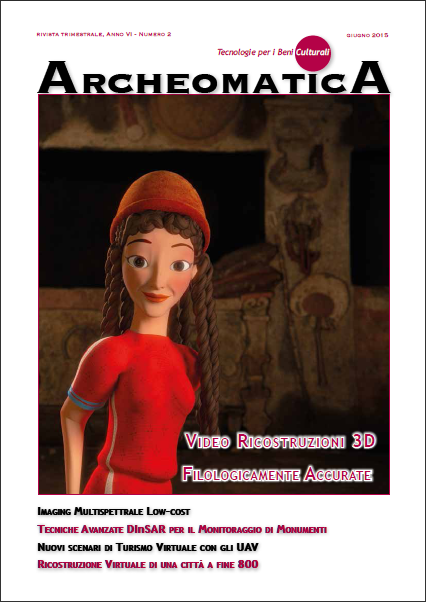Osservazione dei fenomeni deformativi nel centro di Roma. Dall'applicazione di tecniche avanzate DInSAR, all'analisi qualitativa della natura del rumore dei dati COSMO Sky-Med
DOI:
https://doi.org/10.48258/arc.v6i2.883Parole chiave:
telerilevamento, sar, insar, interferometria differenzialeAbstract
This work was created to focus the attention on a particular aspect of the
equivocation (aliasing) of the measurements made with Differential SAR interferometry (DInSAR) X-band for the presence of snow. Such equivocation
emerge after a careful interpretation of the results obtained through the
application of techniques Advanced DInSAR (A-DInSAR) for the observation of
the deformation phenomena of the monumental structures in the center of
Rome. The qualitative analysis have enabled the identification of the appropriate
tools of analysis.
The work was developed through the employment of various tools of software
SARPROZ and is part of a PhD in Geoinformation for the University of Tor
Vergata.
Riferimenti bibliografici
Baghdadi, N., et al., (1999). Accuraty of wet snow mapping using similated Radarsat backscattering coefficients from osserved snow cover characteristics. International Journal of Remote Sensing, 20; pp. 2049-
Berardino P., et al,. (2002). A new algorithm for surface deformation monitoring based on small baseline differeential SAR interferograms.
IEEE Trans. Geosci. Remote Sensing. 40; 2375-2383.
Bozzano, F., et al., (2011). Scenario di danneggiamento indotto nella città di Roma dalla sequenza sismica aquilana del 2009. Italian Journal of Engineering Geology and Environment, vol. 2.
Casagli, N., et al., (2012). Satellite radar interferometry for monitoring and early-stage warning of structural instability in archaeological sites. Journal of Geophysics and Engineering, 9 (4), S10.
Ferretti, A., et al,. (2001). Permanent scatterers in SAR Inteferometry. IEEE Transaction on Geoscience and Remote Sensing 39 (1); pp.
–20.
Ferretti, A., et al,. (2001) - Permanent scatterers in SAR interferometry, IEEE Transactions of Geoscience of Remote Sensing, 39; pp.
–20.
Ferretti, A., et al,. (2003). Valutazione degli effetti di scavi in falda sui cedimenti strutturali di edifici mediante utilizzo di tecniche
satellitari SAR. Atti del Convegno - Crolli e affidabilità delle strutture, Napoli.
Ferretti, A., et al,. (2011). A new algorithm for processing interferometric data-stacks: SqueeSAR. Geoscience and Remote Sensing, IEEE Transactions on, 49(9); 3460-3470.
Fossati, D., (2003).Tecnologie innovative di telerilevamento satellitare per la gestione del territorio. The example of the Oltrepo Pavese
(Lombardia, Italy), Engineering Geology, 88(3-4); pp. 240-259.
Hallikainen, et al., (1993). Application of ERS-1 SAR data to snow mapping. Proceedings of the First ERS-1 Symposium: Space at the Service of our Environment, Cannes, France. ESA SP-359, vol.2; pp. 589-594.
Koskinen, J., et al., (1994). Capability of radar and microwave radiometer to classify snow types in forested areas. IGRASS'94, vol.
; pp. 1283-1286.
Marsella, M.A., et al., (2008). Two-scale surface deformation analysis via the SBAS-DInSAR technique: a case study of the city of Rome,
Italy. International Journal of Remote Sensing, vol. 29:6; pp. 1665-1684.
Marsella, M.A., et al., (2011). Long-term deformation analysis of historical buildings through the advanced SBAS-DInSAR technique:
the case study of the city of Rome, Italy. Journal of Geophysics and Engineering, vol. 8; pp. 1-12.
Marsella M.A., (2012) Analysis of ground deformation using SBAS-DInSAR technique applied to Cosmo-Skymed images, the test case
of Rome urban area Proc. SPIE Remote Sensing 2012 Symposium.
Marsella, M.A., (2013) An application of the SBAS DInSAR technique for the assessment of structural damage in the city of Rome (Italy) Submit to Structure and Infrastructure Engineering Maintenance, Management, Life- Cycle Designand Performance Taylor&Francis
(inpress).
Perissin, D., et al, (2011). SARPROZ manual - link 9.
Perissin, D., et al, (2011a). Subway Tunnels Identification through Cosmo-SkyMed PSInSAR Analysis in Shanghai. In Processing of IEEE
Geoscience and Remote Sensing Symposium, Vancouver, BC, Canada, 24–29 July 2011; pp. 1267–1270.
Perissin, D., (2012). Repeat-Pass SAR Interferometry With Partially Coherent Targets. IEEE Transactions on Geoscience and Remote Sensing, 50(1); pp. 271-280.
Rott, H., et al,. (1993). Snow and glacier investigation by ERS-1 SAR-first result. Proccedings of the First ERS-1 Symposium: Space
at the Service of our Environment, Cannes, France. ESA SP-359, vol.2, pp. 577-582.
Stramondo, S., (2008). Subsidence induced by urbanization in the city of Roma detected by advance InSAR technique and geotechnical investigations. Remote Sensing of Environment
(6); pp. 3160-3172.
##submission.downloads##
Pubblicato
Come citare
Fascicolo
Sezione
Licenza
Gli autori che pubblicano su questa rivista accettano le seguenti condizioni:- Gli autori mantengono i diritti sulla loro opera e cedono alla rivista il diritto di prima pubblicazione dell'opera, contemporaneamente licenziata sotto una Licenza Creative Commons - Attribuzione che permette ad altri di condividere l'opera indicando la paternità intellettuale e la prima pubblicazione su questa rivista.
- Gli autori possono aderire ad altri accordi di licenza non esclusiva per la distribuzione della versione dell'opera pubblicata (es. depositarla in un archivio istituzionale o pubblicarla in una monografia), a patto di indicare che la prima pubblicazione è avvenuta su questa rivista.
- Gli autori possono diffondere la loro opera online (es. in repository istituzionali o nel loro sito web) prima e durante il processo di submission, poiché può portare a scambi produttivi e aumentare le citazioni dell'opera pubblicata (Vedi The Effect of Open Access).





